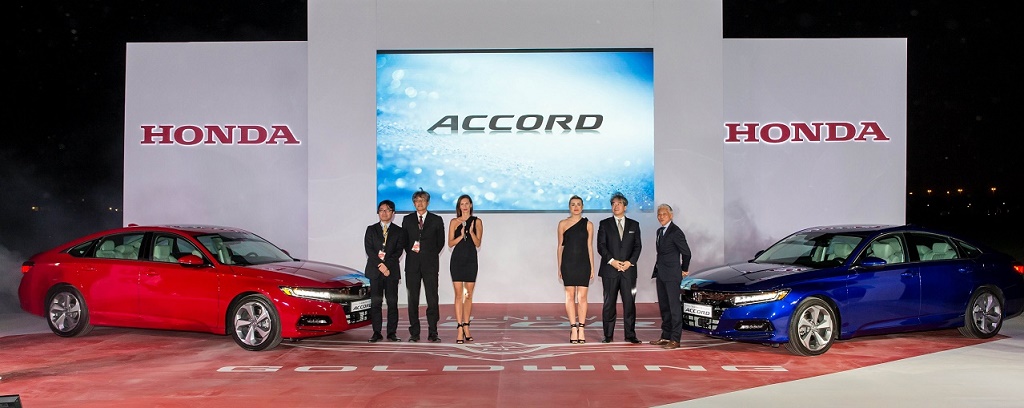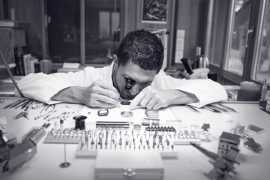Honda launches its10th generation Accord
By Huiming_Shi Sunday, 25 March 2018 11:07 AM

The 2018 Accord is the 10th generation of Honda’s perennially best-selling midsize sedan. All new from the ground up, the new Accord is built on a new platform with a lower, wider stance, a lighter and more rigid unibody structure; a lighter and more sophisticated chassis; two advanced new power units, including Accord’s first-ever turbocharged engines, a new 10-speed automatic transmission.
In recreating Accord for its 10th generation, Honda designers and engineers sought to convey “absolute confidence” in every element of design and performance. Building on the bedrock character of Accord – its outstanding quality, fuel efficiency, packaging and sophisticated driving dynamics – they have imbued the 10th-generation Accord with a new level of emotional appeal and premium quality; an Accord that defies its mainstream midsize sedan status, providing even more refined and engaging performance, a more spacious and upscale interior, and the latest generation of advanced Honda safety and driver-assistive technologies.
In summary, the most dramatically styled, premium and fun-to-drive Accord yet.
What’s New?
Virtually everything on the Accord is new and substantially reengineered. Major new engineering features and technologies for the 10th-generation Accord redesign are as follows:
Body
- 29 percent ultra-high strength steel, the highest ever for a mass-produced Honda
- ACEÔ front body structure with crash stroke design
- Laser-brazed roof skin
- Rear crush zones with Softzone technology
- First use of structural adhesives in Accord
- First application of acoustic spray foam to Accord
- Lighter (10 Kg, body-in-white), and more rigid (+24 percent torsional stiffness, +32 percent bending stiffness)
Chassis
- Aluminum intensive front suspension with new ultra-rigid aluminum and steel sub-frame
- Multi-link rear suspension with floating sub-frame
- Two-Mode Driving System (Sport trims)
- Dual-pinion, variable-ratio electronic power steering
- Electronic Brake Booster (EBB)
- Electric Parking Brake (EPB) with Automatic Brake Hold
- Six percent lighter chassis (excluding tires and wheels)
- Three new alloy wheel designs (17” and 18”)
Powertrain
- 1.5-liter direct-injected VTEC® Turbo with dual Variable Timing Control (dual VTC)
- Available 2.0-liter direct-injected VTEC® Turbo with dual VTC
- Available 10-speed automatic transmission^
Connectivity and Driver-Assistive Technology
- HONDA SENSING®
- Available 8-inch Display Audio (EX trim and above)
- Available 6-inch Head Up Display (2.0T Sport trim)
Packaging and Design
In reimagining Accord, designers first established the fundamental packaging strategy. Consistent with the “Man Maximum-Machine Minimum (MM)” design philosophy that underpins all Honda designs, the team shrunk the Accord’s footprint while expanding its interior space, at the same time creating more premium and athletic proportions and stance. The move to 4-cylinder engines across the lineup is a key component of this approach, allowing a shorter engine bay while also reducing weight and improving dynamic performance.
The new Accord has a longer wheelbase (+55 mm), a lower overall height (-15 mm), a wider body (+10 mm) and a shortened overall length (-15 mm). A sweeping greenhouse, positioned farther back on the body, completes the new stance and proportion of the next-generation Accord. The combined effect of these changes is a more premium look, highlighted by shorter overhangs, a bold front fascia, a long and low hood, and a visual center of gravity moved closer to the rear wheels.
Viewed head-on, the new Accord's greenhouse also angles in more sharply from the window sills to the roof, further emphasizing the wide lower body, while inside the cabin the seats have been moved slightly inward, which contributes to improved hip, shoulder and head room while enhancing occupants' freedom of movement. In addition, the longer wheelbase allowed designers to move the second-row seats substantially rearward, giving Accord 48 mm of added rear legroom. Overall passenger volume is increased by 70 liters (LX trim) and trunk space, at 473 liters on all models and trims, is up 25 liters on 1.5-liter and 2.0-liter models.
Elegant and modern exterior detailing compliments the Accord's new, more dynamic design. The bold and upright front fascia is highlighted by Honda's signature chrome wing front grille positioned above a large main air intake and flanked by available 9-lamp full-LED headlights and LED fog lights. The chiseled hood features a distinctive and aggressive raised center, and the deeply sculpted body sides enhance the visual length and strength of the lower body.
A new laser brazing process that joins the roof to the body side panels creates a clean exterior appearance with no need for a garnish over the rain channels. The similarly low and wide rear view is finished off with an upswept decklid, distinctive LED light-pipe taillights and available integrated dual exhaust ports.
First introduced in 1976, the Honda Accord is the second longest-running automotive nameplate in Honda’s history, after the Honda Civic. The Accord was the first automobile from a Japanese automaker to be manufactured in America and has been in continuous production at the company’s Marysville, Ohio auto plant since November 1, 1982, using domestic and globally sourced parts. Total global Accord production exceeds 17.5 million units. In 1987, Accord became the first U.S-made automobile from a Japanese automaker to be exported overseas (Accord Sedan to Taiwan).
Accord has also played an important role in advancing low-emissions vehicle technology in America and was the first Honda automobile to meet California’s ULEV, SULEV and SULEV30 emission standards.




























Add new comment